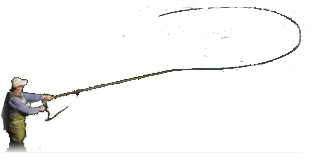Weekly Fraser Valley Sport Fishing Column, Dec 7 to 14, 2015
As I said last week, this year we have decided to cover some basic sport fishing implements, in the lead up to Christmas; in hope of generating a greater appreciation for those things that many anglers wish to find under the tree.
Rods: I have long recommended that you take your angler shopping for this item, rather than trying to make a good choice yourself. It is my hope that the following will enlighten you, as to why I always make this recommendation.
Fishing rods were first seen by Roman Soldiers during their conquest of Western Europe, when they encountered tribes they named ?Angles,? because these tribes fished with rods and lines. Further documentations of this were made over the years; the most commonly referred to, was made by Aelianus in 300 A.D.
The first published instructions on rod making were written by the literary great grandmother of all sport fishing writers, Dame Juliana Berner?s in 1496. Yes, in times past if you wanted a fishing rod for yourself, or to give it as a gift, you made it yourself; and with hours of toil I might add. Rods of this period were made from Hazelwood; and started with a nine foot butt section that doubled at a walking staff. The top end of the butt section was burnt hollow with a hot iron, to enable the top end of the rod, to be retracted in side for storage. After the butt section was made, the top piece was made from an additional section of Hazelwood, trimmed and finished to fit securely into the butt. The top piece was then further finished by splicing a tip of Blackthorn, Crabtree, or Juniper, to the business end of this top section. There crude telescopic type rods were the mainstay of fishing rods up until the early 1800?s, when commercially built rod became available. During this time consumers could choose from many different woods (thanks to world trade), and rod lengths of up to eighteen feet. By 1840 Indian Greenheart with ferruled connections were the preferred rods of the majority of anglers. American violin and arms maker, Samuel Phillippe, introduce Bamboo Cane as a rod making material in 1846, but it would not become vastly popular and perfected for rod making, until Tonkin Cane was discovered in Indo-China, in 1880.
We will continue with this history of fishing rods next week.
The Report
Our lower mainland lakes are fishing slow to fair. For your best watch your barometer and focus on any upward swings in air pressure. Try: Chironomid, Bloodworm, Wooly Bugger, Doc Spratley, Halfback, Micro Leach, Pumpkinhead, or Baggy Shrimp.
The Fraser River is slow to fair for late coho, spring, chum. For coho try: Coho Blue, Christmas Tree, olive or black Wooly Bugger, Coho killer, Bite Me, or Rolled Muddler. For spring try: Big Black, GP, Flat Black, Squamish Poacher, Popsicle, or Kauffman?s black Stone. For chum try: Popsicle, Flat Black, Christmas Tree, Dec 25th, Met Green, or Holliman.
The Harrison River is slow to fair for cutthroat, coho, spring, and chum. For cutthroat try: Rolled Muddler, American Coachman, Tied Down Minnow, Stone Nymph, Eggo, Cased Caddis, Czech Nymph, Hares Ear Nymph, or Irresistible.
The Vedder River is slow for the odd clean coho.




 Reply With Quote
Reply With Quote